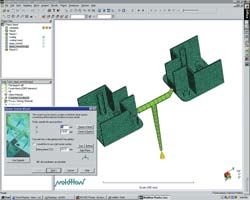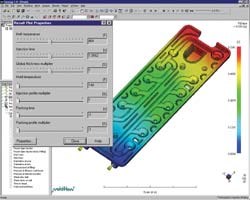Molding Simulation Gets Easier Than Ever
In the mid-'90s, when Peter Rucinski worked for a plastics resin supplier, he broke his company's record by performing 30 mold simulations in one year.
In the mid-'90s, when Peter Rucinski worked for a plastics resin supplier, he broke his company's record by performing 30 mold simulations in one year. Nowadays, he says he could do 30 simulations in a month. That's a testimony to the increasing power of personal computers and to the greater speed and ease of use of molding simulation software. Today, Rucinski is director of product marketing at Moldflow Corp. in Wayland, Mass. Major improvements in usability of simulation software was a key topic at the International Moldflow User Group Conference held in Boston last month.
There, mold and part designers heard about the latest enhancements to Moldflow's software. The vast majority of attendees had already adopted the new version of Moldflow Plastics Insight (MPI) 3.0, which came out last November. Moldflow discussed last month's release of MPI 3.1, which contains upgrades intended to convert the last holdouts reluctant to switch from MPI 2.0. In particular, MPI 3.1 rectifies the inability of MPI 3.0 to "read" old simulation results performed in MPI 2.0. It also runs filling and cooling faster than MPI 3.0.
MPI 3.0 is a major overhaul of Moldflow's flagship product. It brings together the best software technologies from both Moldflow and C-Mold, which Moldflow acquired in 2000. Rucinski hopes the arrival of MPI 3.0 and 3.1 will convince those who have so far resisted adoption of molding simulation that it is now easy enough to learn and use—and also accurate enough—to justify the investment.
Simpler & more accurate
A brand-new option in MPI 3.0, which will be available in 3.1, is called Moldflow Design Link (MDL) 3.0. It increases both simulation accuracy and ease of use because it imports CAD geometry (surface or solid) directly into MPI. In the past, you had to mesh the part in a CAD package and then import the meshed model into MPI. Some geometric detail could be lost in the process. MPI 3.0/3.1 can import and manipulate the CAD geometry before meshing. The result is that MPI analyzes a more accurate representation of the original CAD model.
MDL 3.0 now accepts CAD data in Parasolid (UGS and SolidWorks), IGES, or STEP file formats—and also for the first time, ProEngineer files.
MPI 3.0 also introduced a brand-new user interface that simplifies model preparation for analysis and is also much quicker to learn. "The older MFView preprocessor had hundreds of commands to learn and memorize," says Rucinski. "The new interface is much simpler, cleaner, and more streamlined." For example, reducing the number of on-screen buttons eliminates the "airliner cockpit" look.
Other new features include more powerful ability to divide the model into "layers." These user-specified layers contain just the features of interest for a particular task. For example, MPI can automatically search out "problem" mesh elements (excessively distorted) and assign them to their own layer. Turning off other layers makes it easy to spot the "bad" elements so that they can be deleted or corrected.
MPI 3.0 and 3.1 ease model preparation by allowing you to preview mesh density throughout the part to ensure that you have enough nodes in areas of important detail. New mesh-repair tools also save time. In addition, MPI no longer has any preset limits on numbers of nodes or mesh elements in a model. This helps users simulate parts of greater size and complexity.
MPI 3.0 and 3.1 introduce a number of "wizards" to help simplify model preparation. Cavity Duplication and Runner System Wizards speed creation of balanced multi-cavity layouts. The new Cooling Circuit Wizard addresses a time-consuming task by asking the user only for the channel diameter and the offset distance above and below the cavity—and then does the rest. Another new wizard speeds creation of mold inserts of conductive copper alloy used to aid cooling.
Still another significant new feature is the Design of Experiments (DOE) Manager. It tests the effect of multiple variables on moldability and part quality. DOE Manager automatically sets up and runs multiple analyses according to the parameters you specify. Output displays let you move on-screen "slider bars" for each variable to see how changing values alters simulation results on a line graph or color-coded contour map of the part.
Enhanced analysis tools
Two of the most important simulation tools in MPI 3.0/3.1 are MPI/Fusion and MPI/3D. Although not new, both have been significantly enhanced in the new releases.
MPI/Fusion eliminates the tricky task of creating a midplane model out of the part solid model. "Creating the midplane model used to be the most time-consuming step of an entire simulation project, sometimes taking over a week," Rucinski notes.
MPI/Fusion has also been enhanced with what Moldflow product-line manager Dean Piepiora says was the most eagerly requested upgrade in MPI 3.0. In the past, if you needed to change the thickness of any part of a Fusion model—to add a flow leader, for instance—you had to go back and change the original solid model outside of MPI and then rerun the Fusion meshing procedure. Now it is possible to view and change a Fusion model's thickness within MPI 3.0 or 3.1.
Fusion's capabilities have also been extended to include analysis of fiber orientation and warpage, as well as thermoset/reactive molding and microchip encapsulation.
Simulation is now also simpler when it comes to thick, chunky parts that are not accurately approximated by a midplane model. In 1998, Moldflow came out with MPI/3D to analyze such parts accurately by using solid tetrahedral mesh elements. But users had to apply the mesh manually to the CAD solid model—no simple task—before importing it into MPI. New in MPI 3.0/3.1 is a 3D mesh generator that automatically creates a tetrahedral mesh from the CAD solid model imported into MPI.
The merger of C-Mold and MPI technologies now also allows MPI/3D to simulate thermoset parts, which tend to be thick and chunky. Other MPI/3D enhancements include clamp-force prediction and the ability to simulate in-mold labeling.
More additions from C-Mold allow MPI/Gas to model fiber orientation and warpage in gas-assist molding. C-Mold's simulations for coinjection and injection-compression are also part of MPI 3.0/3.1. Merging the materials databases of C-Mold and MPI resulted in a library of over 7500 materials, which Moldflow says is the most extensive available for simulation anywhere.
Handle data better
Interpreting simulation results is also simpler in MPI 3.0/3.1. Now, for example, you can "lock" together multiple windows showing different data on the same model—e.g., weld lines in one window, temperatures in another, and shrinkage in a third. When you rotate, pan, or zoom any window, the action is now duplicated in the others.
Another handy new feature is the ability to show two different analyses of the same part—with different materials or molding conditions—in adjoining windows and to retain the same color scale for parameters of interest. Thus, the same color shade on either part corresponds to the same numerical value of that parameter. Such side-by-side comparisons were more difficult when red just meant the highest value on the scale for each window, but the scales were often different.
Related Content
How to Achieve Simulation Success, Part 1: Model Accuracy and Mesh Decisions
Molding simulation software is a powerful tool, but what you get out of it depends very much on your initial inputs. Follow these tips to create the most successful simulation possible.
Read MoreHow to Achieve Simulation Success, Part 2: Material Characterization
Depending on whether or not your chosen material is in the simulation database — and sometimes even if it is — analysts will have some important choices to make and factors to be aware of. Learn them here.
Read MoreRead Next
See Recyclers Close the Loop on Trade Show Production Scrap at NPE2024
A collaboration between show organizer PLASTICS, recycler CPR and size reduction experts WEIMA and Conair recovered and recycled all production scrap at NPE2024.
Read MoreLead the Conversation, Change the Conversation
Coverage of single-use plastics can be both misleading and demoralizing. Here are 10 tips for changing the perception of the plastics industry at your company and in your community.
Read More






















